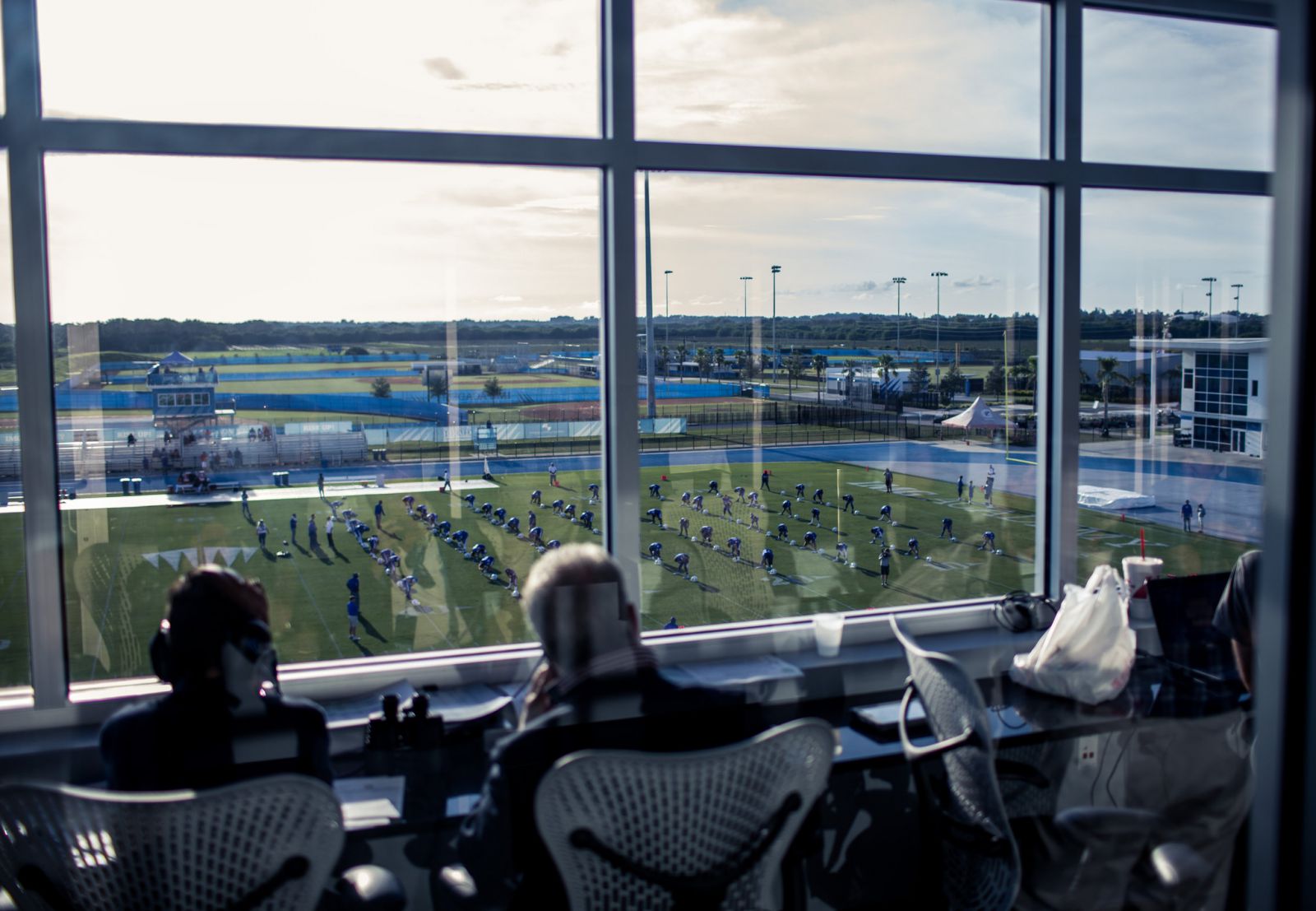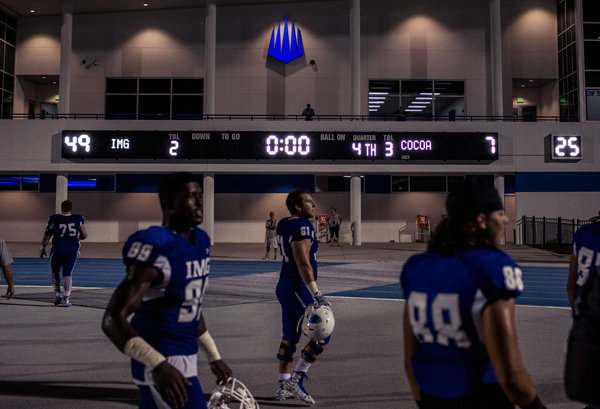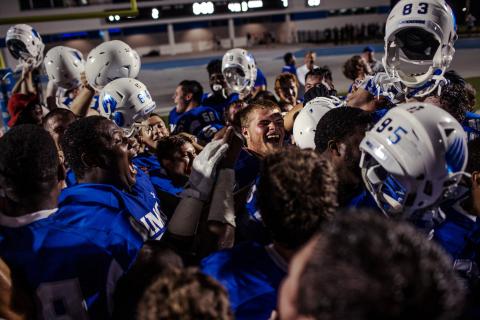BRADENTON, Fla. — The sun had not yet set last Friday on a field ringed by palm trees when, on the first play from scrimmage, Shea Patterson rolled to his left and threw a 69-yard touchdown pass for his high school, IMG Academy, a private, for-profit sports boarding school.
On the academy’s campus, a onetime tomato farm, the latest experiment in prep football is taking root and could produce, depending on one’s view, bountiful harvests of talent or a blight of professionalism. Coaches and officials around the country are watching with curiosity and wariness.
Patterson, who is considered the nation’s top high school quarterback, threw the scoring pass to receiver Drake Davis, a national indoor sprinting champion. By halftime, Patterson had thrown four touchdown passes, including one to Isaac Nauta, who is rated as the country’s No. 1 tight end prospect.
IMG Academy throttled Cocoa High School, a public school, 49-7, in a contest that many had expected to be a taut battle between two national powers from Florida but was so lopsided that a mercy rule took effect in the second half and sped the game.
“We’re the best team in the country,” said Patterson, 18, a senior who is 6 feet 2 inches and 192 pounds, has a quick release, and has thrown 104 career touchdown passes with eight interceptions at three high schools.
Nauta, 18, who is 6-4 and 237 pounds, said: “Every day in practice is just a grind against our own guys. That’s probably the best competition we’re going to face all year.”
Their assuredness is as bold as the company behind the school: IMG, the global sports management conglomerate that has helped propel the competitive leap high school football has made beyond traditional community teams.
Those teams still exist. But convention is being challenged by a more professional model at the highest levels as top players urgently pursue college scholarships, training becomes more specialized, big business opens its wallet, school choice expands, and schools seek to market themselves through sports, some for financial survival.
Increasingly, prep football talent is being consolidated on powerful public, private, parochial, charter and magnet school teams. And recruiting to those schools is widespread in one guise or another.

IMG is at the forefront. It is trying to enhance its academy brand with football, perhaps the most visible sport. And it is applying a business model to the gridiron that has long been profitable for tennis and has expanded to golf, soccer, baseball, basketball, lacrosse, and track and field. The academy has nearly 1,000 students from more than 80 countries enrolled in prekindergarten through 12th grade and postgraduation. About half the students are international.
The school, 45 miles south of Tampa, recruits football players from around the country. It offers high-performance training, college preparatory courses, coaches with N.F.L. playing experience, facilities that resemble a small college more than a high school, and a chance to play a national schedule and on ESPN against some of the highest-rated teams.
Though IMG Academy has fielded a varsity football team for only three seasons and, as an independent school, is ineligible to play for a Florida state championship, it is stocked with six of the nation’s top 100 senior recruits. The roster has players from 21 states and six countries. This month, IMG flew to Texas for a game. On Saturday, it traveled to New Jersey and defeated another power, Bergen Catholic High School, 59-47.
The full cost of tuition and boarding for a year of football at IMG Academy is $70,800, although need-based financial assistance is available. School officials would not provide specific figures, but they said that payments by families could range from tens of thousands of dollars to a competition fee (from $3,750 to $4,500) to nothing.
Team helmets are adorned not with a lion or a tiger but with IMG’s corporate logo. The cheerleaders and the pep band come not from the school but are themselves all-star performers from the area. Even the team nickname, the Ascenders, suggests players are there with college in mind.
The academy was founded in 1978 by Nick Bollettieri as a tennis boarding school on what he often says were 15 acres of repurposed tomato fields. Andre Agassi, Serena Williams and Maria Sharapova have trained there.
IMG bought the academy in 1987, and it now covers more than 500 acres. Football began in 2013 as part of a $197 million campus expansion. Games are played in a 5,000-seat stadium outfitted with suites and a jumbo video screen. Digital screens depict each player’s name and face on his locker. Some N.F.L. players train there in the off-season, as do college players preparing for the pro draft.
IMG officials are upfront about their profit motive. And they have been backed financially by state lawmakers. They justify the assistance by citing the academy’s economic impact to the region in training more than 12,000 athletes yearly from the youth level to the pros and in hosting numerous amateur and professional sports competitions.
Although it is private, IMG Academy has received more than $7 million from the Florida state budget over the past two years, according to news accounts. An additional $2 million was pledged by lawmakers in June but was then vetoed by Gov. Rick Scott.
“We run a business,” said Chip McCarthy, a co-managing director of IMG Academy. “We call it sales and marketing. Some people call it recruiting. We’re promoting our program. If you look at any private school that emphasizes sports, they’re typically doing it to promote their school. A lot are trying to survive. You’re not going to curtail that.”
McCarthy added: “With us, we’re very honest about it. We recruit nationally, we don’t recruit in Florida, and we’re probably the only school in the country that admits it.”
Officials at IMG also freely say that the academy is not for everyone. Several highly regarded players have left, citing homesickness, a philosophical clash with coaches or a feeling of being overwhelmed by the collegelike commitment.
Many high school football coaches and officials are closely following IMG Academy, wondering whether it portends the growth of similar academies or superleagues featuring top teams.
“I’m 50-50 split,” said John Wilkinson, the coach at Cocoa High School, who faced IMG Academy last week and said he would do it again. “They’re high school kids, just like us. We’re playing a football game. The other 50 percent thinks the competitive advantage they have is kind of alarming, if they’re allowed to recruit. But it is what it is.”

Left, the IMG locker room. Right, linebacker Rahshaun Smith at his locker before the game. Credit Photographs by Edward Linsmier for The New York Times
Some Florida schools refuse to play IMG Academy. Some coaches from other states are upset that IMG has poached players whom they developed. And there are accusations — vehemently rebutted by IMG — that it is merely a football factory where “student” is a neglected companion in the term “student-athlete.”
Other officials express fear that football might follow the path of high school basketball, which many feel has been corrupted by so-called diploma mills and the heavy influence of club teams and recruiting middlemen.
“We just wouldn’t play them,” George Smith, the athletic director at St. Thomas Aquinas High School in Fort Lauderdale, said of IMG Academy. He won six state championships and two national championships as the St. Thomas Aquinas football coach. “They’re exactly like all these basketball schools, except they’re a football school.”
Mickey McCarty, who has coached three state championship teams at Neville High School in Monroe, La., and who lost a senior receiver to IMG Academy days before fall practice began, said the academy seemed less a traditional football team than a showcase for individual talent.
“It sounds to me like they’re playing for self, to be promoted and recruited, which takes away everything we stand for,” McCarty said.
Another view, of course, is held by IMG Academy. Criticism often seems to be uninformed and secondhand, said McCarthy, the academy’s co-managing director.
Academy officials said that 186 athletes from IMG’s 2015 graduating class were playing various college sports, including six at Ivy League universities and four at service academies. Academics and athletics are intended to simulate the college experience with dormitory living, alternate-day classes, block scheduling and a focus on time management.
“It is the best preparation for a high school kid to get to the next level quick,” said Kevin Wright, IMG Academy’s first-year head coach.
A school guide describes a typical day for athletes: Breakfast from 6:30 to 7:30 a.m. Three classes lasting 80 minutes each. Forty minutes of tutoring and preparation for standardized tests. Lunch. Training and conditioning from 1:30 to 5:30 p.m. Dinner. Another hour of available tutoring and a mandatory 90-minute study hall.
Football players said there was a curfew at 10:30 p.m.
“I came here assuming it was going to be easy, it’s just going to be a football school, but I learned within the first week I was completely wrong,” said Kjetil Cline, 17, a senior receiver from Minnesota who plans to play football at the United States Military Academy. “That really opened my eyes about what college would be like, and I think it’s really prepared me for going to West Point and being able to handle that.”
To be admitted into the Florida High School Athletic Association, IMG Academy agreed not to recruit athletes from Florida schools. The association said that it had received accusations of recruiting in-state by IMG but that none had been substantiated.
The National Federation of State High School Associations has not taken an official position on IMG Academy, said Bob Gardner, the association’s executive director.
But he added: “Academy teams, while they may be good teams and give great educations, it’s not something that we really believe in or would promote or espouse in any way. We think the high school experience is best served by the student-athlete who lives at home with his family and is part of his school, family and community.”
The players at IMG and their families consider that approach to be antiquated. For Patterson, a quarterback who won state championships the previous two seasons at a high school in Louisiana, IMG Academy is serving as a finishing school.
Patterson said he transferred to IMG in June to work on his speed, strength and conditioning. He plans to graduate in December, enroll for the spring semester at the University of Mississippi and challenge for the starting quarterback position there next fall as a freshman.
“It’s definitely a professional decision,” he said.
Steve Walsh, IMG Academy’s director of football, and Rich Bartel, the offensive coordinator, both played quarterback in the N.F.L. There are also sports psychologists, strength coaches and speed coaches to assist Patterson. He has at his disposal a 10,000-square-foot weight room; a sports science center to aid with hydration and nutrition; a biomechanics center; a vision lab, or “mind gym,” to enhance perceptual and cognitive skills; and a hospital for special surgery and sports rehabilitation should he be injured.

Announcers and members of the news media watching the team warm up. Credit Edward Linsmier for The New York Times
When IMG Academy played in Texas this month, it trained at Texas Christian University, and Wright, the Ascenders’ coach, said, “We’re thinking, ‘Hey, our practice fields are maybe a little bit better.’ ”
At the top levels of high school football, some teams routinely travel to play teams in other states. Games are frequently broadcast on regional or national cable channels. Some players are offered college scholarships as early as eighth grade.
Apparel companies also exert considerable influence. Nike operates training camps for select players. Under Armour sponsors a postseason all-star football game and IMG Academy itself, where players are told not to wear gear made by other companies.
“It’s all driven by money, and you can’t beat money,” said John Bachman Sr., who coached Patterson to state titles the past two seasons at Calvary Baptist Academy in Shreveport, La. As a freshman, Patterson played at a high school in Texas.
Bachman said he felt conflicted about Patterson’s decision to transfer to IMG Academy. Parents should have the right to choose the best school for their children, he said. If he had a son of Patterson’s skill, Bachman said, he would have considered the same move.
“I’m a liar if I said I wouldn’t have,” Bachman said.
Even so, he added, “I don’t think anything’s ever going to take the place of the local public high school or private school that pours itself into the kid, and it’s a family atmosphere and it’s about the team and sacrifice and so on.”

IMG players after their 49-7 win over Cocoa. Credit Edward Linsmier for The New York Times
Calvin Ashley, a top-rated junior tackle, left IMG Academy last spring and returned to his former school, Dr. Phillips High School, in Orlando, Fla. Rodney Wells, the football coach there, said that Ashley was homesick.
“There’s a reason kids go to college when they are 18 and not 15, 16 or 17,” Wells said. “Calvin is only 16. A college atmosphere, being away from home, living in a dorm, that’s not an environment for a 16-year-old. You don’t have your neighborhood buddy. You can’t go home to your mom.”
But for others, like Patterson, who is 18, IMG has been a comfortable fit. His grandfather played for a season with the Detroit Pistons. His father and three older siblings played collegiate sports. He said that IMG Academy “was going to get me the most ready on the field and academically” to play next season at Ole Miss.
“There’s a lot more accountability,” Patterson said. “I’ve got to be at class every day at 7:45. Can’t skip a class. Can’t skip a study hall.”
Sean Patterson Sr., Shea’s father, said, “If your son’s a great musician, you want to send him to Juilliard,” adding that for Shea, IMG Academy “is the spot” for polishing his football skills for college.
“Some kids don’t want to leave that high school experience,” Sean Patterson Sr. said, describing his son’s transfer from Louisiana. “It’s important for them to have pep rallies. Shea’s already been through that. Sometimes you just know it’s time to move on.”
Dressed in an Ole Miss shirt and hat, he added: “Who knows what they’re going to want him to do, but he’s going to be ready. They open with Florida State next year.”


Spread the word